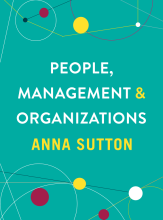Summary: Operations And Sales
- This + 400k other summaries
- A unique study and practice tool
- Never study anything twice again
- Get the grades you hope for
- 100% sure, 100% understanding
Read the summary and the most important questions on Operations and sales
-
1 Introduction to operations management
This is a preview. There are 2 more flashcards available for chapter 1
Show more cards here -
4 Basic issues in relation to organisational design
1. The nature of hierarchy
2. The degree of centrilasation
3. The extent of formalisation
4. The level of complexity -
Explain tall and flat organisations
Tall: Many layers between CEO and workforce
Flat: Few layers between CEO and workforce -
Expain highly centralised and decentralised
Highlycentralised : Power is held at the centre and ALL decisions are made byCEO
Decent: Low-level managers have authority to make decisions and take actions -
How is the opreations function organised? (3 steps)
System -- Clearly identifiable, regularly interacting, interrelating groups of activities
Boundary around the system -- detemrines what is in the system and what is not
Simultaneous multiple containment -- interrelated and made up of subsystems, which are subsystems of a larger system -
The relationship of OM with Other Management Functions
A key aspect of any organisation is its ability to ensure collaboration across the different areas -
What does an Operations Manager do?
Managing the Shot Term and Long term
Ordered or “Messy” Management -
Processes - the heart of operations management - 4Vs
Volume: The size or scale of output/number of items manufactured or customers served.
Variety: Size of product range or number of services offered.
Variation: How the level of demand changes over time/seasonal lunchtime in a restaurant.
Variability: The extend to which each product or service may be customised./steak: Medium/rare/welldone -
The distinguishing Features of services
Intangibility - the services do not physically exist, but are directly experienced by customers -
Heterogeneity - consumers have unique experiences of services that are the same as other consumers; different level of satisfaction -
Perishability - serviced cannot be inventoried or put into stock; it is essential to ensure services are used to their maximum/ an airline seat cannot be sold twice; -
Simultaneity - service is provided at the same time as it is requested -
Inseparability - providing service as the same place as the customer -
Processing Materials, Customers and Information
1. Materials processing operation (MPO) - Materials: physical and come in all kinds of shape and sizes
2. Customer processing operation (CPO) - Human: made of the same material - flesh and blood, but has different needs and wants and behaviour
3. Information processing operation (IPO) - Collection of facts and data; Internet revolution - from spoken word to writing, then printing and digital revolution; The information systems do: handle large info, perform complex calculation and control many processes at the same time -
Managing the Shot Term and Long term
Short term - operation activity within the factory, shop, or smith on a minute-by-minute basis
Long term - the development and investment in process that will lead to the organisation’s success
- Higher grades + faster learning
- Never study anything twice
- 100% sure, 100% understanding
Topics related to Summary: Operations And Sales
-
Sales - Managing the customer portfolio
-
Supply chain and processes - Understand supply chains
-
Manufacturing vs services - List key characteristics of manufacturing
-
Manufacturing vs services - Recognise that manufacturing and services have different operations management requirements
-
Process analysis - List 4 methods of documenting a process
-
Process analysis - List 4 data gathering techniques
-
Load & Capacity - Describe load & demand and understand the relationship between both terms
-
Planning and scheduling
































